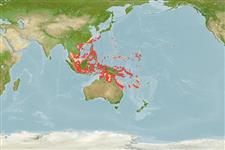>
Eupercaria/misc (Various families in series Eupercaria) >
Caesionidae (Fusiliers) > Caesioninae
Etymology: Pterocaesio: Greek, pteron = wing, fin + Latin, caesius = blue grey (Ref. 45335).
More on author: Bleeker.
Environment: milieu / climate zone / kisaran kedalaman / distribution range
Ekologi
laut berasosiasi dengan karang; nir-ruaya; kisaran kedalaman 0 - 50 m (Ref. 402). Tropical; 30°N - 24°S, 97°E - 171°E (Ref. 402)
Indo-Wes Pacific.
Report from Réunion (Ref. 4517) is probably a misidentification of Pterocaesio marri.
Length at first maturity / Size / Weight / umur
Kematangan: Lm 21.3 range ? - ? cm
Max length : 30.0 cm TL jantan/; (Ref. 402)
Duri punggung (Keseluruhan (total)) : 10; duri punggung lunak (Keseluruhan (total)) : 14 - 16; Duri dubur: 3; Sirip dubur lunak: 11 - 12. Body blue to greenish dorsally, white ventrally. With two thin yellow to orange lines; lower line mostly just below lateral line. Black tips on caudal fin (Ref. 48636). 4-5 scales on cheek; 24-31 predorsal scales; scaled dorsal and anal fins. Upper peduncular scale rows usually 12 or 13 (11-14); lower peduncular scale rows usually 16 or 17 (16-18). A broad process on ventrolateral surface of basioccipital for attachment of Baudelot's ligament, extending ventrally beyond a horizontal with condyle's rim, adjacent to condyle. Post maxillary with 2 processes; posterior end of maxilla tapered (Ref. 1723). Head length 3.0-3.5 in SL; body depth 3.5-4.1 in SL (Ref. 90102).
Body shape (shape guide): fusiform / normal; Cross section: compressed.
Found in coastal areas, primarily around coral reefs (Ref. 402), turning bright red (Ref. 48636). Feed on zooplankton in midwater aggregations (Ref. 402). Oviparous, with numerous, small pelagic eggs (Ref. 402).
Mating behavior observed from an aquarium include six distinguishable patterns: 1) up and down swimming; 2) courtship; 3) rushing; 4) pair spawning; 5) sperm release by sneakers; and 6) post spawning (Ref. 37529).
At nearly sunset, the usual quiet pack of fish give way to spawners swimming at the surface. A male selects a female and initiates pecking and pushing of the female's abdomen with his snout. At the rushing stage, the male pushed the female forward, and the couple began to swim in a semicircle in short bursts while other 10-15 sneakers within the school joined in. The initial couple then released eggs and sperm at the surface with their abdomens facing one another. Some of the leading sneakers may also release sperm at the same spot where the initial couple spawned. After spawning, the pair with the sneakers return to the school (Ref. 37529).
Carpenter, K.E., 1987. Revision of the Indo-Pacific fish family Caesionidae (Lutjanoidea), with descriptions of five new species. Indo-Pac. Fish. (15):56 p. (Ref. 1723)
Status IUCN Red List (Ref. 130435: Version 2025-1)
ancaman kepada manusia
Harmless
penggunaan manusia
Perikanan: komersial
Alat, peralatan
laporan khas
muat turun XML
Sumber internet
Estimates based on models
Preferred temperature (Acuan
123201): 24.7 - 29, mean 28 °C (based on 702 cells).
Phylogenetic diversity index (Acuan
82804): PD
50 = 0.5002 [Uniqueness, from 0.5 = low to 2.0 = high].
Bayesian length-weight: a=0.01175 (0.00648 - 0.02132), b=3.15 (2.99 - 3.31), in cm total length, based on LWR estimates for this species & Genus-body shape (Ref.
93245).
Trophic level (Acuan
69278): 3.4 ±0.48 se; based on food items.
Daya lenting (Acuan
120179): sedang, Waktu penggandaan populasi minimum 1.4 - 4.4 tahun (tm=2-3).
Fishing Vulnerability (Ref.
59153): Low vulnerability (20 of 100).
🛈
Nutrients (Ref.
124155): Calcium = 55.6 [35.8, 81.2] mg/100g; Iron = 0.675 [0.441, 0.997] mg/100g; Protein = 18.8 [17.8, 19.7] %; Omega3 = 0.14 [0.10, 0.20] g/100g; Selenium = 28.6 [17.5, 48.8] μg/100g; VitaminA = 147 [57, 378] μg/100g; Zinc = 1.25 [0.91, 1.66] mg/100g (wet weight);
